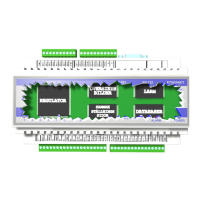6
47
6 - Controllers
6�2 Viewing controller data
The "View" menu now contains separate tabs for each controller.
Open a controller
The controller data appears at the top of the page. You are not able to modify this data. If there is a
curve, it appears in the middle of the page. You can use drag-and-drop to alter the breakpoints. For
more advanced curve settings, see section 8.
Other adjustable parameters appear at the bottom of the page. Important: Each row must be
updated separately�
The next page shows the data page for the controller we congured earlier.
6�3 Denitions
6�3�1 Set value displacement
The set value can be shifted up or down by a channel, a digital input or a weekly programme. If
there are multiple active displacements, the values are added together. The eect of a channel
depends on the content of the channel. If the channel is an analog input with a displacement, say,
of 0—10 V = 0—10 degrees, a 5 V signal at the input creates a 5 degree displacement. The channel
could also create a set value displacement on the basis of the room temperature. This requires a
control curve and some graphical programming. The digital input and the weekly programme each
have a xed level, which you specify when you congure the controller. You can change the settings
at any time in the controller's "View" page.
6�3�2 Control functions
Most controllers operate according to one of two principles – constant or compensated. The con-
stant principle means that the controller set value is kept constant, for example when controlling a
hot water circuit. The compensated principle means that the set value is modied dynamically by
another input signal on the basis of a curve.
6�3�3 Pump operation
As well as managing various types of actuator, the controller can also start, stop and switch pumps,
fans, etc.
6�3�4 Feedback alarm
An alarm is triggered by the combination of a digital output and a digital input. As long as they have
the same status, there is no alarm. However, an alarm is triggered as soon as their statuses diverge.
Suppose the digital output is controlling a contactor for the circulation pump. An auxiliary contact
on the contactor is connected to the digital input. If the motor circuit breaker is tripped, the con-
nection to the input is interrupted, triggering an alarm. The alarm could also be used to start a spare
pump or a twin pump.

